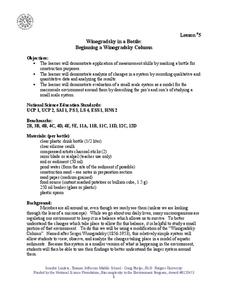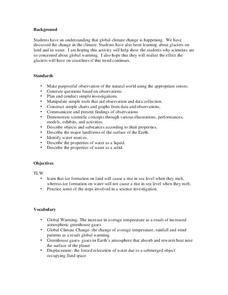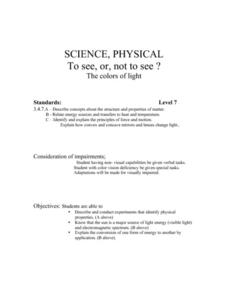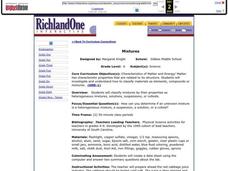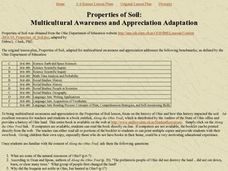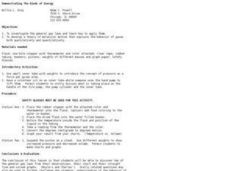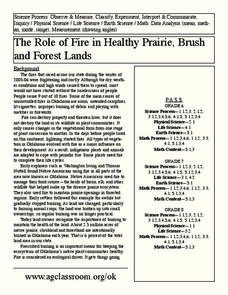Curated OER
The Investigation Of The Taste Buds
Students explore the sense of taste. In this biology lesson plan, students investigate the sense of tastes as they experience salty, sour, bitter, and sweet tastes. Students then discover how taste buds do their job.
Curated OER
Capillary Action Dip N' Dye
Students complete an experiment to observe capillary action. In this capillary action instructional activity, students add food coloring to a bowl and watch what happens as they dip the corner of the paper in it. Students observe...
Curated OER
Winogradsky in a Bottle: Beginning a Winogradsky Column
Students study changes in the environment using a microscale experiment. In this environmental science activity, students construct a modified "Winogradsky Column" to observe bacteria activities. They record observations and formulate a...
Curated OER
Global Climate Change
Second graders investigate the effect of melting glaciers to sea level. In this earth science lesson, 2nd graders simulate the process in the lab by conducting an experiment using ice cubes and clay. They explain the consequences of...
Curated OER
Mr. and Mrs. Cress Head
Students explore Earth science by completing a plant art project. In this botany lesson, students utilize tights and soil to create a furry, grassy puppet style animal from cress seeds. Students cut off the excess cress after several...
Curated OER
Sound Vibrations
Students examine how vibrations are responsible for the sounds we hear. Students experience vibrations using several of their senses.
Curated OER
SOUND VIBRATIONS
Student designs a test that uses their sense of hearing to judge the effectiveness of different solids to transmit sound vibrations. Students experience vibrations using several of their senses.
Curated OER
Matter
Third graders are introduced to the topic of matter. As a class, they brainstorm what they already know about matter and its properties. After completing a worksheet, they participate in an experiment in which they observe matter in...
Curated OER
To See or Not to See: The Colors of Light
Seventh graders describe and conduct an experiment that identifies the physical properties of light. They explore sources of visible light and an electromagnetic spectrum. Students explain the conversion of one form of energy to another.
Curated OER
Mixtures
Sixth graders experiment with mixtures. In this chemistry lesson plan, 6th graders determine which mixtures are considered heterogeneous, a suspension, a solution or a colloid. Students create a data sheet of what they discover.
Curated OER
Properties of Soil
Students encounter various pieces of knowledge utilizing lessons that addresses a diversity of learners with multiple intelligences. They cover various concepts: science, Earth, scientific inquiry, geometry, data analysis, probability,...
Curated OER
Sour Acids and Bitter Bases
Young scholars explore acids and bases. They experience the sour taste of acids and the bitter taste of bases by tasting substances such as chocolate, lemon juice, and baking soda. in addition, they complete a worksheet for individual...
Curated OER
Plate Tectonics
Students reinforce their knowledge of plate tectonics from what they have already learned on the subject. In this science lesson, students watch a small clip from the movie "Ice Age" which engages the students to participate throughout...
Curated OER
Wondrous Water
Students explore the different properties of water. They experimenting with different activities, each one explaining a different property of water. Students read an article "Small, Ues, But Might: The Molecule Called Water." and then...
Curated OER
4-H Horticulture/Garden Activity Page- Beginning
For this 4-H garden project worksheet set, student study the parts of seeds and plants. They make a mini-greenhouse. They complete a career scavenger hunt, tools word search, and experiment to learn more about the effect of water on seed...
Curated OER
Growing Tomatoes from Seed
In this growing tomatoes worksheet, learners experience and participate in the process of growing tomatoes over a three or four month span of time. Students follow six directives in producing tomato plants.
Curated OER
Density of Liquids
Students explore the density of liquids. In this scientific inquiry lesson plan, students discover the density of water, corn syrup, and cooking oil through an experiment. In addition, students will draw and label pictures of the...
Curated OER
Demonstrating the Kinds of Energy
Young scholars experiment with inner tubes, weights, flasks, and pistons to demonstrate the gas laws. In this molecular motion lesson, students demonstrate pressure as a force per area. They conduct an experiment to show the relationship...
Curated OER
Cornstarch Suspension
Students explore the different textures of cornstarch. In this science lesson, students use various cornstarch and water recipes to explore the textures of each mixture.
Curated OER
The Role of Fire in Healthy Prairie, Brush and Forest Lands
Students create a Venn diagram to compare and contrast wildfires and prescribed fires. In this earth science lesson, students conduct a series of experiment to explore fire characteristics. They describe favorable conditions to start a...
Curated OER
Ocean Currents
Learners discover the geography of Earth by analyzing water currents. In this oceanography lesson plan, students create visual references on a map of the globe where and why major ocean currents are moving water. Learners...
Curated OER
Microbe Power- Using a Winogradsky Column as a Battery
Students demonstrate the changes that take place when they complete their experiment. In this battery lesson students complete a lab activity.
Curated OER
Tongue Map
Students explore human anatomy by conducting a human senses experiment. In this taste lesson, students identify the main purpose of a tongue and how it enhances our eating habits. Students utilize baking coca, lemon juice, salt and honey...
Curated OER
Some of Its Parts
Young scholars study a can opener to find the important parts that make it possible to take the lid off a can of food. They then use this information to decide what new or different subsystems could be added to make it better and...


